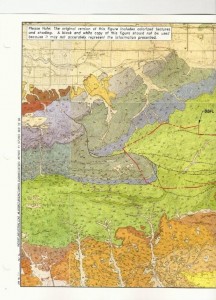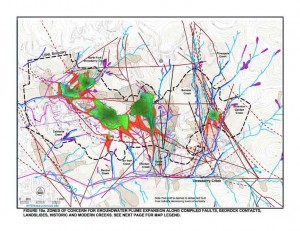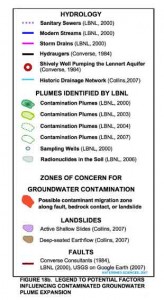The eastern ESADA area was used as pistol range and remains polluted with dangerous amounts of antimony, arsenic, boron, lead, and selenium. Aluminum, vanadium and, not surprisingly, sodium are also found in high concentrations. All ESADA buildings have been demolished.
Parts of the area are sandbagged forcing some surface water flow towards so-called Outfall 6 which leads down into the American Jewish University, Brandeis-Bardin Campus in western Simi Valley. There in Meier Canyon, which receives downhill Area IV runoff down multiple channels, signs nailed to oaks say “WARNING – DO NOT DRINK OR USE THIS WATER.”
Between August 1988 and May 2007, 77 soil samples and 16 soil vapor samples were collected to assess potential impact associated with the chemical use areas at the ESADA, according to the 3,410 page Group 8 Western Portion of Area IV – Volume III Appendix C and D prepared for Boeing, dated September 2007. Two monitoring wells were used to specifically characterize ESADA groundwater.
The Process Development Unit was closely analyzed for volatile and semi-volatile organic compounds, polychlorinated biphenyls or PCBs, total petroleum hydrocarbons and heavy metals to “evaluate their presence due to the documented storage of ‘green liquor’ waste water, which contains organic compounds, sulfur compounds, and ash,” according to a 1993 report that made up part of the assessment. The 8,000 gallon tank for the green goo has been since removed.
The report’s high results were astounding though perhaps not surprising considering the plethora of pollution at the lab. Aluminum, sodium, and vanadium were detected above background concentrations at the ESADA’s former chemical storage yard with concentrations of aluminum and vanadium that exceeded ecological Risk Based Screening Levels, or RBSLs, but were less than human health RBSLs.
RBSLs are used by the U.S. Environmental Protection Agency to “help identify areas, contaminants, and conditions that require further federal attention at a particular site,” according to the agency. “They are risk-based concentrations derived from standardized equations combining exposure information assumptions with EPA toxicity data.”
Vanadium in the soil exceeded the background concentration at one ESADA location while “five metals, (antimony, arsenic, boron, lead, and selenium) exceeded background concentrations, residential RBSLs, and/or ecological RBSLs at the ESADA Pistol Range,” according to the 2007 study.
“The maximum concentration of antimony (up to 870 mg/kg), arsenic (up to 350 mg/kg), and lead (up to 27,000 mg/kg) were detected in samples collected in the target (i.e., south) area of the pistol range.”
ESADA antimony ranged up to 100 times background, arsenic over 23 times normal for the site and 9,000 times lab background for lead. Lead was also found at elevated levels in the groundwater. “Based on lead concentrations in soil, lead is potentially site-related in groundwater.”
“Organic chemicals above regulatory criteria include benzene, toluene, benzoic acid, bis(2-chloroethyl)ether, and gasoline-range hydrocarbons,” the report noted of the soil.
Making sense of these soaring numbers is complex but not impossible. A so-called Hazard Quotient (HQ) and Hazard Index (HI) are utilized to determine risk to humans and the environment including wildlife. “HQs are hazard estimates for single CPECs [Contaminant of Particular Ecological Concern], while HIs are cumulative hazard estimates for all CPECs,” the report reads. “For comparison purposes, HQ or HI values less than 1 represent conditions that would not cause unacceptable ecological impacts. HQ or HI values greater than 1 typically require additional evaluation, and may be deemed acceptable or unacceptable by risk managers.”
Kids don’t fair so well in the “Future Child Resident” scenario where they score a whopping twenty. Of course, the land is not supposed to be developed for residents after the cleanup so no children will live on the property. That the HI exceeded the child resident scenario by twenty times, though, is a significant indicator of the level of contamination at the ESADA site.
Animals do live at the lab and have easy access to the ESADA through the porous perimeter of the Santa Susana Field Laboratory. Additionally, there is an open gate leading to Runkle Canyon two hundred yards to the west of the ESADA. Critters might best stay away according to the beasts’ Hazard Index in the report.
“The deer mouse, thrush, hawk and mule deer have estimated HIs in excess of 1,000, while the bobcat has an estimated HI in excess of 100,” says the study. “These HIs are primarily associated with antimony, arsenic, lead, and selenium.”
All Downhill from Here
“The Burro Flats Fault, located in the southern part of the Group 8 Reporting Area, strikes approximately east-west in the vicinity of the ESADA RFI Site,” the study says citing two previous reports in 1992 and 2002. “Chatsworth formation groundwater flow is toward the northwest. Estimated horizontal gradients in the vicinity of the ESADA RFI Site are approximately 0.1 foot/foot, based on recent groundwater level measurements.”
Northwest from this location leads to Runkle Canyon. But do contaminants travel down earthquake rifts like the Burro Flats Fault that curves into the canyon? Recent studies suggest so.
An April 2004 analysis, published in the Vadose Zone Journal, looked at Yucca Mountain, 80 miles northwest of the Las Vegas. It was the proposed site for the nation’s main nuclear waste repository from 1987 to 2009 when the project was killed partly over active earthquake faults and volcanoes but not before costing over $90 billion.
The report, “Development of a Wet Plume Following Liquid Release along a Fault,” was carried out “in situ” or at the actual Yucca Mountain site instead of a laboratory. The study’s conclusions don’t bode well for Runkle Canyon’s heavy metal dilemma.
“We observed that water (introduced along the fault) maintained the fault as the primary vertical flowpath, while the adjacent fractured rock served to move water laterally and vertically,” the study said.
A year later, the late Jim Slosson told this reporter in an interview that the fault lines in the western part of Santa Susana Field Laboratory are interconnected with those in adjacent Ahmanson Ranch, which abuts Runkle Canyon’s southern border. Slosson was quoted in a February 2005 Los Angeles CityBeat-ValleyBeat article called “Pipe Dreams”:
At issue is the interconnectivity between the Ahmanson aquifer and the heavily polluted groundwater underneath Rocketdyne’s lab. “They are definitely connected by way of faults, and the faults are significant as far as the groundwater migration,” says Jim Slosson, former state geologist under Governor Reagan and now chief engineering geologist for Slosson and Associates, his Van Nuys-based geology consulting firm. “I think that would be almost a stupid move because the greatest part of the contaminated aquifer in the Ahmanson Ranch area is in area immediately right up there by Burro Flats,” he said, referring to Rocketdyne’s radiological area, the site of a partial nuclear reactor meltdown in 1959 as well as numerous other nuclear accidents and mishaps.
Two years later, a comprehensive study of another site with chemical and nuclear contamination in an area riddled with faults came out and was called “Contaminant Plumes of the Lawrence Berkeley National Laboratory and the Interrelationship to faults, Landslides, and Streams in Strawberry Canyon, Oakland and Berkeley, California.”
The 55-page (128mb) March 2007 report was authored by Laurel Collins, a geomorphologist with Berkeley-based Watershed Sciences and Pamela Sihvola, Project Manager Committee to Minimize Toxic Waste. One map of the area, pictured here with its legend, shows “groundwater plume expansion along compiled faults.”

“[G]roundwater can transfer along any number of pathways (bedrock contacts, faults and landslide failure planes) and in any order of combination,” the report reads. “Furthermore, potential surface water contamination is possible along drainages that intersect faults, landsides, and bedrock contacts that intersect contaminant plumes.”












Aaah, the money issue. Spot on Constance!
Environmental felons like Boeing need to do the right thing and buy out the Runkle developer, clean that land up to SB990 standards, then convert it to open space once cleaned to SB990 standards.
If one checks out Boeing’s income statement, they will find the polluter has enough greenbacks to handle KB with ease. All corporations have insurance companies, maybe EnviroReporter can obtain the insurance policies?
In fact, the polluter has more than enough to also buy out poisoned Woosley-Dayton where there are similar problems.
Being that Boeing is a contractor of the federal government may have some bearing on who they hide behind when push comes to shove. The buck might be passed back to DOE, NASA, the Defense Department, and etcetera. It might be a good idea to consult with attorneys from NRDC, CBG, and so forth.
IANAL, but couldn’t KB Home sue Boeing for the pollution? I don’t think Boeing has any special protection – SSFL is not a Superfund site, right? Assuming KB Home never gets to develop, they’re going to want to recover their investment somehow.
Unless Boeing simply buys them out to avoid the lawsuit.
Michael,
I’m very surprised to see you didn’t mention Tom Seckington or interview him for this piece. Without him weighing in, this report has much less credibility. For those who don’t know, he’s the DTSC Hydro-geologist who’s been studying groundwater movement at SSFL for (I think) 17 years. I’ve been working and consulting with him for the last 3 years and I find him to be the acknowledged expert on SSFL groundwater as well as one of the most honest people working on this project. He’s been totally dedicated to helping our community.
Perhaps you could do a follow up on this report after you talk to him.
Nice work, Mr. C.
I am frankly alarmed that there is a newish citizens group on the other side of the pass from the wonderful rangers that takes in ‘donations’ from the environmental felon mentioned above in the second comment above. This is something it is hoped will not impact the clean-up effort, but this writer feels otherwise. Do you think you can possibly check out the ‘donation’ history and find out more regarding the frequency and amount of polluter’s contributions? It sure sounds like dirty money is on its way to usurp the Hill’s detox marathon that we know is still in its infantile stages at the moment.
Btw, your good work does not go unnoticed.
The Radiation Rangers rock! Indeed, it would be a grand day if and when Runkle follows the example of Ahmanson and is never allowed to be used for residential space, NEVER EVER. Hats off to Mary Weisbrock who sets the bar high for Hawkeye, Toxic Terry, Good Rev John, and the rest of the crew with Mary’s (and her group, Save Open Space) previous involvement in the saving of Ahmanson Ranch. It looks like Runkle is on the same path (fingers crossed). We are very fortunate to have these wonderful people by the community’s side.
Hopefully, the derisiveness of recent noted in the article above, will come to an end. It’s just plain silly to let the badgering fester on, even though the article’s author is 100% in the right. Hypocrisy has a definition and it is this: “having desirable or publicly approved attitudes, beliefs, principles, etc., that one does not actually possess” — the email exchange with DTSC as mentioned is but one erratic example of many; some of which will most likely be uncovered as time goes by, having known the antics of said local perpetrator. . .
Advice: please focus on your marvelous investigations and don’t stop! You guys are just too valuable to let little things get in your way. The community can see through the pettiness, the fraud, the abuse, the indecency, the injustice. We have your back and we scorn the backstabbers out there be it an errant regulator, a mal-adjusted activist, or an ignorant neighbor. Keep on keeping on!
Michael,
This is truly an amazing piece of investigation that you have done. It seems as if you are now extending your terrific reporting skills into becoming a discovery making geologist. Would that you could also do a similar scientific reporting exploration of the whole SSFL—all 2850 acres. Dream on!
From everything I have been able to read or hear discussed, it certainly seems to me that these underground acquifers and earthquake faults could absolutely be the source of our most scary, on-going and long term contamination nightmares. And, they are frequently described as being “poorly understood”. By comparison,soil sampling and removing dangerous surface contamination may turn out to be child’s play.
I certainly hope that you will keep up your good work in Runkle Canyon, and that you will continue to keep the KB builders paralyzed. So far, you and the Radiation Rangers have been more successful at doing this than even the recession.
When you have some free time, I hope that you will come over to Chatworth Park-South, which is just a few blocks away from where I and over 750 Rockpointe condo owners live. We have an underground water situation here involving the longest 7,000 ft.train tunnel (#26) in the USA,located at the North end of our beautiful Chatsworth Park S. The trains go from the Chatsworth station to Simi Valley.
This train tunnel happens to be located at the Southern end of the Chatsworth geological formation…which, I believe, originates up on the SSFL. We have 4300 gallons of underground water flowing, DAILY, through sump pumps in the tunnel, and being ultimately dumped into Chatsworth Park S., which is slowly being turned into a wetland.
The original Railroad builders ran into this water problem in about 1898, when they were constructing the railroad tracks. That’s how long this problems has been going on. Although the tracks have since been raised, the tunnel still gets flooded during the rainy season.
The Water Quality Board has been contacted, has visited the tunnel, and, they in turn have ordered the Railroad to obtain an NPDS permit to “de-water”. This permit process is pending, and we are all very concerned about radionuclides or toxic contaminants that could possibly be in this water…since it could very likely be flowing down underground all the way from down the Chatsworth Formation,from the SSFL. The railroad is apparently required to do some water testing before they can be granted a permit.
In the meantime, the Rangers and other residents should give you an ACADEMY AWARD.